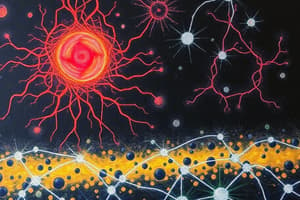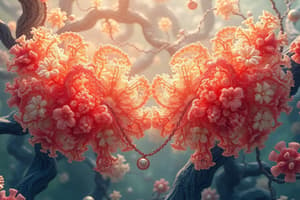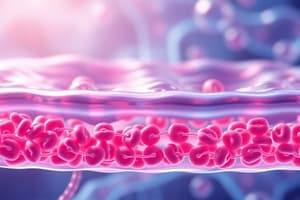Podcast
Questions and Answers
Which of the following is a primary function of membrane proteins?
Which of the following is a primary function of membrane proteins?
- Synthesizing glucose molecules
- Transport of substances across the membrane (correct)
- Facilitating DNA replication
- Storing genetic information
Peripheral proteins are embedded within the hydrophobic interior of the lipid bilayer.
Peripheral proteins are embedded within the hydrophobic interior of the lipid bilayer.
False (B)
What type of membrane junction provides mechanical stability by tightly linking cells together, especially in tissues subject to stress?
What type of membrane junction provides mechanical stability by tightly linking cells together, especially in tissues subject to stress?
desmosomes
__________ are transmembrane proteins that facilitate cell movement within developing embryos and can contribute to the spread of cancer cells.
__________ are transmembrane proteins that facilitate cell movement within developing embryos and can contribute to the spread of cancer cells.
What is the primary function of membrane carbohydrates in cell-cell recognition?
What is the primary function of membrane carbohydrates in cell-cell recognition?
Match the following membrane protein/structure with its primary function:
Match the following membrane protein/structure with its primary function:
Peripheral membrane proteins are covalently bonded to the membrane surface.
Peripheral membrane proteins are covalently bonded to the membrane surface.
What type of interactions hold the molecules of the membrane together allowing for lateral movement?
What type of interactions hold the molecules of the membrane together allowing for lateral movement?
__________ are carbohydrates attached to proteins on the outer surface of the cell membrane.
__________ are carbohydrates attached to proteins on the outer surface of the cell membrane.
Match the membrane components with their functions:
Match the membrane components with their functions:
Which characteristic of biological membranes allows them to selectively control the passage of molecules?
Which characteristic of biological membranes allows them to selectively control the passage of molecules?
The 'fluid mosaic model' describes the biological membrane as a rigid, static structure with components locked in place.
The 'fluid mosaic model' describes the biological membrane as a rigid, static structure with components locked in place.
What are the three main components of a biological membrane?
What are the three main components of a biological membrane?
The __________ nature of phospholipids allows them to form bilayers in water.
The __________ nature of phospholipids allows them to form bilayers in water.
Match the membrane component with its primary function:
Match the membrane component with its primary function:
Which of the following best describes the role of cholesterol in maintaining membrane fluidity?
Which of the following best describes the role of cholesterol in maintaining membrane fluidity?
How does compartmentalization within a cell or organelle contribute to its efficiency?
How does compartmentalization within a cell or organelle contribute to its efficiency?
Which aspect of the phospholipid bilayer contributes to its fluidity?
Which aspect of the phospholipid bilayer contributes to its fluidity?
Saturated fatty acids in phospholipids increase membrane fluidity due to the presence of double bonds.
Saturated fatty acids in phospholipids increase membrane fluidity due to the presence of double bonds.
Briefly explain the functional significance of the asymmetric arrangement of lipids in the cytosolic and extracellular leaflets of the plasma membrane.
Briefly explain the functional significance of the asymmetric arrangement of lipids in the cytosolic and extracellular leaflets of the plasma membrane.
Explain how a cell membrane's selective permeability contributes to cellular homeostasis.
Explain how a cell membrane's selective permeability contributes to cellular homeostasis.
At low temperatures, a membrane's fluidity decreases because phospholipids become tightly ______.
At low temperatures, a membrane's fluidity decreases because phospholipids become tightly ______.
Match the fatty acid type with its effect on membrane fluidity:
Match the fatty acid type with its effect on membrane fluidity:
What primarily drives passive transport across cell membranes?
What primarily drives passive transport across cell membranes?
Active transport moves substances against their concentration gradient.
Active transport moves substances against their concentration gradient.
What is the function of aquaporins in passive transport?
What is the function of aquaporins in passive transport?
In ____________, a cell engulfs large particles or entire cells.
In ____________, a cell engulfs large particles or entire cells.
Which of the following transport mechanisms is highly specific, involving binding of macromolecules to receptor proteins on the cell membrane?
Which of the following transport mechanisms is highly specific, involving binding of macromolecules to receptor proteins on the cell membrane?
Exocytosis involves bringing materials into the cell via vesicles.
Exocytosis involves bringing materials into the cell via vesicles.
What role do transport proteins play in facilitated diffusion?
What role do transport proteins play in facilitated diffusion?
Match the type of transport with its description.
Match the type of transport with its description.
Flashcards
Cell Membrane Function
Cell Membrane Function
Separates internal cell environment from the external environment.
Selective Permeability
Selective Permeability
Selects which molecules enter or exit based on size and charge.
Compartmentalization
Compartmentalization
Organelles enclose chemicals in specific areas, increasing reaction efficiency.
Membrane Shape Maintenance
Membrane Shape Maintenance
Signup and view all the flashcards
Endocytosis and Exocytosis
Endocytosis and Exocytosis
Signup and view all the flashcards
"Fluid" in Fluid Mosaic Model
"Fluid" in Fluid Mosaic Model
Signup and view all the flashcards
Phospholipids
Phospholipids
Signup and view all the flashcards
Leaflet
Leaflet
Signup and view all the flashcards
Integral Membrane Proteins
Integral Membrane Proteins
Signup and view all the flashcards
Peripheral Membrane Proteins
Peripheral Membrane Proteins
Signup and view all the flashcards
Integrin
Integrin
Signup and view all the flashcards
Glycolipids
Glycolipids
Signup and view all the flashcards
Glycolipids Function
Glycolipids Function
Signup and view all the flashcards
Glycoproteins
Glycoproteins
Signup and view all the flashcards
Cell-Cell Recognition
Cell-Cell Recognition
Signup and view all the flashcards
Membrane Fluidity
Membrane Fluidity
Signup and view all the flashcards
Increased Membrane Fluidity
Increased Membrane Fluidity
Signup and view all the flashcards
Decreased Membrane Fluidity
Decreased Membrane Fluidity
Signup and view all the flashcards
Cholesterol in Membranes
Cholesterol in Membranes
Signup and view all the flashcards
Membrane Permeability
Membrane Permeability
Signup and view all the flashcards
Passive Transport
Passive Transport
Signup and view all the flashcards
Simple Diffusion
Simple Diffusion
Signup and view all the flashcards
Facilitated Diffusion
Facilitated Diffusion
Signup and view all the flashcards
Channel Proteins
Channel Proteins
Signup and view all the flashcards
Aquaporins
Aquaporins
Signup and view all the flashcards
Carrier Proteins
Carrier Proteins
Signup and view all the flashcards
Active Transport
Active Transport
Signup and view all the flashcards
Endocytosis
Endocytosis
Signup and view all the flashcards
Study Notes
- Cell membranes separate the internal environment of a cell or organelle from its environment.
- Selective permeability is the ability to choose which molecules can enter or exit based on size, charge, and chemical properties.
- Damaging compounds can be kept out and entry of needed compounds is allowed by membranes.
- Compartmentalization occurs when organelles sequester appropriate chemicals in an enclosed area.
- Compartmentalization decreases interference and allows reactants to collide more frequently.
- Cell membranes maintain cell or organelle shape by providing structural support.
- Endocytosis and exocytosis are key functions of biological membranes.
- Biological membranes are described as a fluid mosaic model.
- Lipids and proteins can move fluidly relative to each other within the membrane.
- Biological membranes are a mosaic made up of many discrete components, including lipids, proteins, and carbohydrates.
- Phospholipids form the basic framework of a membrane.
- Proteins are embedded in the membrane or loosely attached to its surface and carry out key functions.
- Carbohydrates may be attached to membrane lipids and proteins and also carry out key functions.
- Membranes of specific cells and organelles differ in the kinds of proteins and lipids.
- Phospholipids are amphipathic molecules.
- Hydrophilic, polar heads are found on the surface of the membrane.
- Hydrophobic, nonpolar tails are found in the interior of the membrane.
- Biochemical properties of phospholipids differ and this affects the fluidity of the phospholipid bilayer.
- The plasma membrane contains a cytosolic leaflet and an extracellular leaflet
- The leaflet is half of a phospholipid bilayer, each side faces a different region with different properties corresponding to different functions and asymmetry.
- Membranes contain diverse proteins based on the membrane's function.
Major Groups of Membrane Proteins
- Integral proteins penetrate the hydrophobic interior of the lipid bilayer.
- Some integral proteins extend across the lipid bilayer, called transmembrane proteins, others are only partially embedded.
- Peripheral proteins are not embedded in the lipid bilayer at all, and are loosely bound to the surface of the membrane.
Major Functions of Membrane Proteins
- Transport occurs through hydrophilic channels, carriers, and pumps
- Enzymatic activity is produced by ATP synthase
- Signal transduction occurs when receptor binding sites fit the shape of chemical messengers
- Glycoproteins serve as recognition identification tags.
- Intercellular joining: gap junctions communicate, tight junctions control movement of materials and desmosomes provide mechanical stability.
- Attachment to the cytoskeleton and extracellular matrix allows for movement and maintains cell shape.
- Plasma membranes adhere to the extracellular matrix.
- Transmembrane integrin binds to the matrix outside epithelial cells and to actin filaments inside cells.
- Integrin binding is noncovalent and reversible.
- Cells can move within a tissue by the binding and reattaching of integrin to the extracellular matrix.
- Integrin attachment is important for cell movement within developing embryos and can enable the spread of cancer cells.
- When integrins can no longer mediate attachment, the cell separates from the matrix structures.
- Cancer cells may spread throughout the body if they have detached from the extracellular matrix.
- Membranes have diverse carbohydrates and the amount varies based on the membrane's function.
Major Groups of Membrane Carbohydrates
- Glycolipids consist of carbohydrate + lipid and facilitate cell recognition (self vs. non-self).
- Glycoproteins consist of carbohydrate + protein and serve as receptors for chemical signals.
Major Functions of Membrane Carbohydrates
- Cell-Cell Recognition: diversity and location of carbohydrates on the membrane allow them to function as markers that distinguish different cells.
- Carbohydrates allow sorting of cells into tissues and organs in animal embryos.
- The presence of carbohydrates on the outside surface of cells is the basis for the rejection of foreign cells by the immune system (defense).
- Membranes must be able to move and change shape in order to function properly.
- Fluidity results from molecules held together by hydrophobic interactions where lipids and proteins can shift laterally.
- Membrane fluidity must remain stable to hold its shape, allow for protein support, avoid permeability changes, and prevent effects to enzymatic proteins.
Factors Influencing Fluidity
- Low temperature decreases fluidity because it decreases energy and increases the concentration of phospholipids.
- High temperature increases fluidity because it increases energy and decreases the concentration of phospholipids.
- Cholesterol acts as a buffer to maintain stability.
- At low temperatures, cholesterol increases fluidity by increasing the distance between phospholipids.
- At high temperatures, cholesterol decreases fluidity by increasing the number of molecules in the space
- Saturated bonds decrease fluidity (single bonds in fatty acid chains pack tightly)
- Unsaturated bonds increase fluidity (double bond(s) in fatty acid chains provide more distance between them).
- Selective permeability is a property of biological membranes that allows them to regulate the passage of substances across them.
- Both the type of substance crossing the membrane and the rate of passage is regulated.
- Nonpolar molecules can cross the lipid bilayer easily without assistance.
- Polar molecules and ions will need assistance from transport proteins to cross the cell membrane.
- Membrane permeability is crucial for homeostasis.
- Membranes are permeable to solutes that can easily cross and impermeable to those that cannot.
- Passive transport energy comes from the concentration gradient and no energy input is required.
- Two types of passive diffusion: simple and facilitated.
- Facilitated diffusion requires no energy input.
- Substances diffuse according to their concentration gradients, aided by transport proteins.
- Channel proteins are transmembrane proteins that form a tunnel:
- Ion channels allow ions to diffuse across the membrane and are typically gated.
- Aquaporins allow water to pass through the membrane during osmosis.
- Carrier proteins are membrane proteins that bind substances and speed their diffusion across the membrane.
- Active transport is energy-dependent transport of a substance across a biological membrane against a concentration gradient or an electrical gradient.
- The energy source is often adenosine triphosphate (ATP).
- Macromolecules are too large to cross the membrane, so they are taken in or secreted by membrane vesicles.
- Endocytosis brings molecules and cells into a eukaryotic cell as the cell membrane folds inward to form a vesicle.
Three Types of Endocytosis
- Phagocytosis occurs when molecules or entire cells are engulfed.
- Some white blood cells engulf foreign substances by phagocytosis.
- A food vacuole or phagosome forms, which then fuses with a lysosome for digestion.
- Pinocytosis occurs when a vesicle forms to bring small dissolved substances or fluids into a cell.
- Receptor mediated endocytosis is highly specific because macromolecules bind to receptor proteins, which are integral membrane proteins at specific sites.
- Exocytosis occurs when materials packaged in vesicles are secreted from a cell when the vesicle fuses with the cell membrane, sometimes without a pore.
Studying That Suits You
Use AI to generate personalized quizzes and flashcards to suit your learning preferences.




